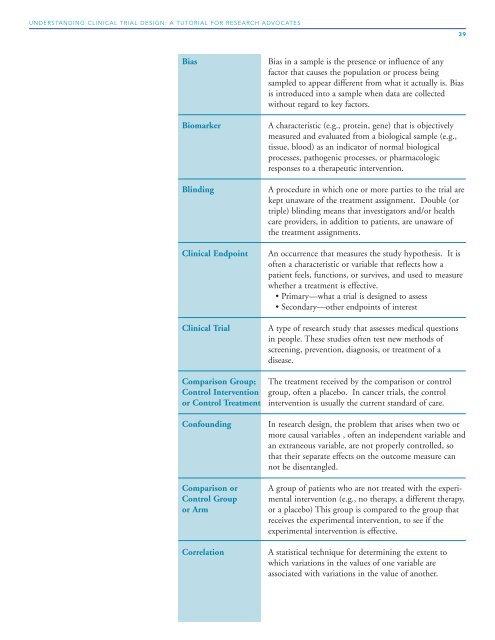Understanding Clinical Trial Design - Research Advocacy Network
Understanding Clinical Trial Design - Research Advocacy Network
Understanding Clinical Trial Design - Research Advocacy Network
Create successful ePaper yourself
Turn your PDF publications into a flip-book with our unique Google optimized e-Paper software.
UNDERSTANDING CLINICAL TRIAL DESIGN: A TUTORIAL FOR RESEARCH ADVOCATES<br />
Bias Bias in a sample is the presence or influence of any<br />
factor that causes the population or process being<br />
sampled to appear different from what it actually is. Bias<br />
is introduced into a sample when data are collected<br />
without regard to key factors.<br />
Biomarker A characteristic (e.g., protein, gene) that is objectively<br />
measured and evaluated from a biological sample (e.g.,<br />
tissue, blood) as an indicator of normal biological<br />
processes, pathogenic processes, or pharmacologic<br />
responses to a therapeutic intervention.<br />
Blinding A procedure in which one or more parties to the trial are<br />
kept unaware of the treatment assignment. Double (or<br />
triple) blinding means that investigators and/or health<br />
care providers, in addition to patients, are unaware of<br />
the treatment assignments.<br />
<strong>Clinical</strong> Endpoint An occurrence that measures the study hypothesis. It is<br />
often a characteristic or variable that reflects how a<br />
patient feels, functions, or survives, and used to measure<br />
whether a treatment is effective.<br />
• Primary—what a trial is designed to assess<br />
• Secondary—other endpoints of interest<br />
<strong>Clinical</strong> <strong>Trial</strong> A type of research study that assesses medical questions<br />
in people. These studies often test new methods of<br />
screening, prevention, diagnosis, or treatment of a<br />
disease.<br />
Comparison Group; The treatment received by the comparison or control<br />
Control Intervention group, often a placebo. In cancer trials, the control<br />
or Control Treatment intervention is usually the current standard of care.<br />
Confounding In research design, the problem that arises when two or<br />
more causal variables , often an independent variable and<br />
an extraneous variable, are not properly controlled, so<br />
that their separate effects on the outcome measure can<br />
not be disentangled.<br />
Comparison or A group of patients who are not treated with the experi-<br />
Control Group mental intervention (e.g., no therapy, a different therapy,<br />
or Arm or a placebo) This group is compared to the group that<br />
receives the experimental intervention, to see if the<br />
experimental intervention is effective.<br />
Correlation A statistical technique for determining the extent to<br />
which variations in the values of one variable are<br />
associated with variations in the value of another.<br />
39


